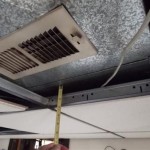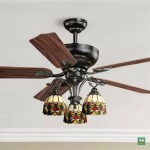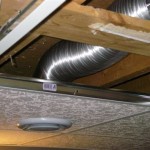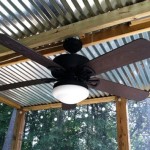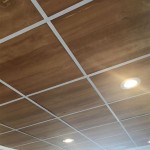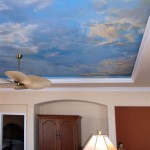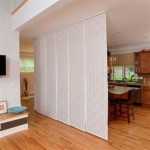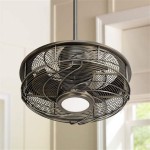Do You Have To Use The Light Kit On A Ceiling Fan?
The question of whether a light kit is mandatory when installing or using a ceiling fan is a common one, particularly among homeowners looking to update or replace their existing fixtures. The answer, however, is not a simple yes or no. It depends on several factors, including building codes, the intended function of the fan, and personal aesthetic preferences. This article will explore the various aspects to consider when deciding whether or not to install or use a light kit on a ceiling fan.
The primary function of a ceiling fan is air circulation. By circulating air, ceiling fans can make a room feel cooler in the summer and warmer in the winter, thereby reducing reliance on air conditioning and heating systems. However, many ceiling fans are also equipped with light kits, which serve as an additional source of illumination for the room. The integration of a fan and light fixture into a single unit is often a space-saving solution, especially in rooms with limited ceiling electrical boxes.
Understanding the electrical and structural considerations is crucial before deciding whether to use a light kit. Ceiling fans, especially those with light kits, require proper installation to ensure safety and functionality. This involves correctly wiring the fan to the electrical system and securely mounting it to a suitable ceiling joist or support structure. Failure to do so can lead to electrical hazards or the fan detaching from the ceiling, posing a significant safety risk.
Building codes and regulations can influence the decision to install a light kit. While codes vary by location, some jurisdictions may require a certain number of light fixtures in a room to meet minimum illumination standards. If a ceiling fan is the primary lighting source in a room, a light kit might be necessary to comply with these regulations. It is advisable to consult local building codes or a qualified electrician to determine the specific requirements in your area.
Aesthetic and Functional Considerations
Beyond practical necessities, aesthetic and functional considerations play a significant role in the decision to use a light kit. Many homeowners prefer the look of a ceiling fan with an integrated light, as it can complement the room's overall design. The availability of various light kit styles, from traditional to contemporary, allows for customization to match different interior design themes. Furthermore, the brightness and color temperature of the light can be adjusted to create the desired ambiance.
Functionally, a light kit provides an additional source of light, which can be beneficial in rooms that require ample illumination. This is particularly useful in living rooms, bedrooms, and kitchens, where a combination of ambient and task lighting is often desired. The light kit can serve as the primary light source or supplement other lighting fixtures in the room, offering greater flexibility in controlling the overall lighting scheme.
Conversely, some homeowners prefer the minimalist look of a ceiling fan without a light kit. In rooms with sufficient natural light or existing lighting fixtures, a light kit may be deemed unnecessary. Removing the light kit can create a cleaner, more streamlined appearance, which is particularly appealing in modern or minimalist interiors. Additionally, a fan without a light kit may be more energy-efficient, as it consumes less electricity.
Before foregoing a light kit, it is crucial to assess the existing lighting conditions in the room. Consider the amount of natural light available during the day, as well as the placement and brightness of other light fixtures. If the room is already well-lit, a light kit may not be essential. However, if the room tends to be dark or poorly lit, a light kit could significantly improve the overall lighting quality.
Electrical and Structural Requirements
The electrical and structural requirements for ceiling fans with and without light kits are generally similar, but there are subtle differences. Both types of fans require a properly wired electrical box that is securely mounted to a ceiling joist or support structure. The electrical box must be rated to support the weight of the fan and any additional components, such as the light kit.
When installing a ceiling fan with a light kit, it is essential to ensure that the wiring is properly connected to both the fan motor and the light fixture. This typically involves connecting the fan motor to a dedicated circuit and the light fixture to a separate circuit, allowing for independent control of the fan and light. Some fans offer the option of controlling the fan and light with a single switch, while others require separate switches or a remote control.
If you choose not to use a light kit, the electrical wiring for the light fixture must be properly capped off and insulated to prevent electrical hazards. This is typically done by disconnecting the wires leading to the light fixture and covering them with wire connectors or electrical tape. It is crucial to ensure that the wires are securely insulated to avoid short circuits or other electrical problems.
The structural integrity of the ceiling is paramount when installing any ceiling fan. The fan and light kit (if applicable) can exert significant weight on the ceiling, particularly during operation. Therefore, it is essential to ensure that the ceiling joist or support structure is strong enough to bear the load. If the ceiling is not adequately reinforced, it could collapse under the weight of the fan, posing a serious safety risk.
Building Codes and Safety Standards
Building codes and safety standards are in place to ensure the safe installation and operation of ceiling fans and other electrical fixtures. These codes vary by location, but they typically address issues such as the minimum height clearance for fans, the proper wiring methods, and the required structural support. It is crucial to comply with these codes to avoid potential hazards and legal liabilities.
Some building codes may require a certain number of light fixtures in a room to meet minimum illumination standards. This requirement is often based on the size and intended use of the room. If a ceiling fan is the primary lighting source, a light kit might be necessary to comply with these regulations. Failure to do so could result in fines or other penalties.
In addition to building codes, there are also safety standards that apply to ceiling fans and light kits. These standards are typically developed by organizations such as Underwriters Laboratories (UL) and the American National Standards Institute (ANSI). Products that meet these standards are tested and certified to ensure their safety and reliability.
When purchasing a ceiling fan or light kit, it is advisable to look for products that are UL-listed or certified by other recognized testing organizations. This indicates that the product has been evaluated and found to meet established safety standards. Using certified products can help to reduce the risk of electrical hazards, fire, and other potential problems.
Furthermore, proper installation is crucial for ensuring the safety and compliance of a ceiling fan. It is recommended to hire a qualified electrician to install the fan, especially if you are not familiar with electrical wiring or structural support. A professional electrician can ensure that the fan is properly wired, securely mounted, and compliant with all applicable building codes and safety standards.

How To Add A Light Kit Your Ceiling Fan Mr Electric

How To Install A Ceiling Fan Light Kit Shockley Electric

How To Replace A Ceiling Fan Light Kit Smafan Com

All About Ceiling Fan Light Kits Ideas Advice Lamps Plus

How To Install A Hampton Bay Ceiling Fan Light Kit Fans Lighting

Private Brand Unbranded Kennesaw 42 In Led Indoor White Ceiling Fan With Light Kit Uc42v Wh Shc The Home Depot

Better Homes Gardens 52 Black Modern Ceiling Fan With 5 Blades Light Kit Remote Reverse Airflow Com

Breezary Ableton Hugger 52 In Black Indoor Ceiling Fan With Remote Control And Light Kit Included 24002 Orb The Home Depot

Hunter Bennett 52 Low Profile Ceiling Fan W 3 Led Light Kit And Remote Black 1 Piece Fry S Food

Mainstays 52 Inch Hugger Indoor Ceiling Fan With Light Kit Black 5 Blades Reverse Airflow Com
Related Posts

